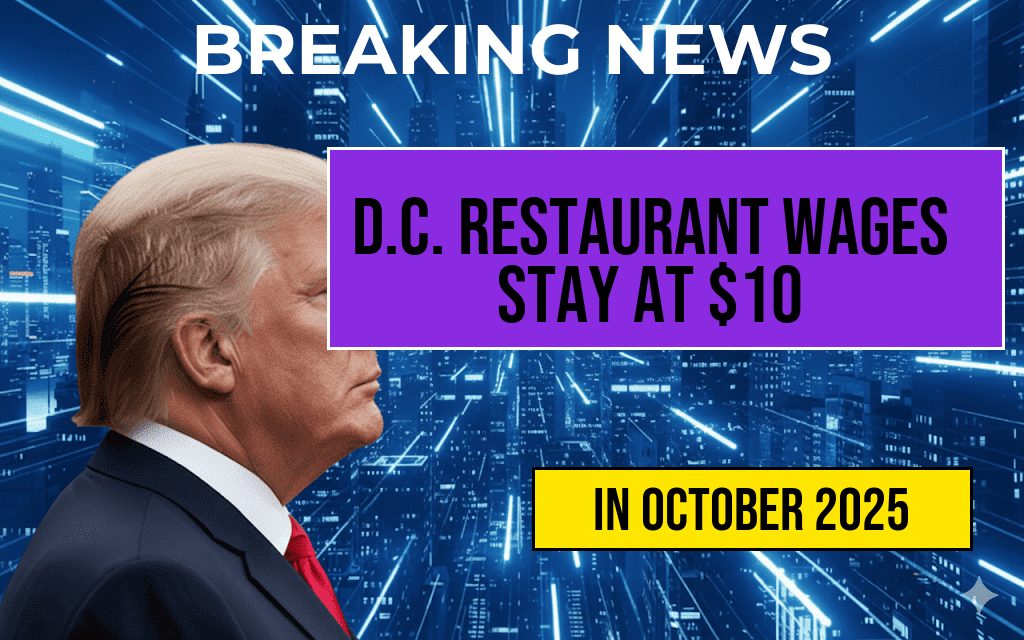Restaurant Workers in D.C. Continue to Earn $10 Hourly as Minimum Wage Stalls, Creating Significant Pay Disparities
Restaurant employees in Washington, D.C., remain stuck at a $10 per hour wage, despite years of calls for a gradual increase aligned with inflation and the rising cost of living. This stagnant rate means that workers earning this wage are effectively earning $4,160 less annually compared to those paid $12 per hour, a disparity that underscores ongoing concerns about fair compensation within the city’s hospitality sector. Local advocacy groups argue that maintaining the $10 minimum hampers workers’ financial stability, especially amid soaring housing costs and inflationary pressures. Meanwhile, restaurant owners cite economic uncertainties and operational constraints as reasons for resisting wage hikes. As policymakers debate potential adjustments, thousands of service workers continue to navigate economic hardship, highlighting broader issues of wage equity and labor rights across the region.
Background: The D.C. Minimum Wage Standoff
The District of Columbia has seen a series of efforts to increase the minimum wage for restaurant workers, with legislation proposed over the last decade aimed at gradually raising pay to align with inflation. However, legislative stalemates and industry pushback have kept the hourly rate frozen at $10 since 2019. The city’s minimum wage for tipped workers remains at the same rate, which, combined with relying heavily on tips, leaves many employees earning well below a living wage.
According to the U.S. minimum wage standards, wages below $12 per hour are increasingly viewed as inadequate in urban centers like D.C. where housing, transportation, and healthcare costs have surged. For context, a worker earning $12 per hour working 40 hours weekly earns approximately $24,960 annually before taxes, while a $10-per-hour worker makes $20,800—creating a $4,160 annual shortfall.
The Impact of Wage Disparities on Workers
| Hourly Wage | Annual Earnings (40 hrs/week, 52 weeks) |
|---|---|
| $12 | $24,960 |
| $10 | $20,800 |
| Difference | $4,160 |
This gap reflects not just a figure on paper but tangible hardships for workers. Many employees report struggling to cover basic expenses like rent, groceries, and transportation. Data from the Bureau of Labor Statistics indicates that low-wage earners are more vulnerable to economic shocks, with limited savings and minimal buffers during downturns.
Stakeholder Perspectives
Worker Advocacy Groups
Organizations such as the Restaurant Workers’ Alliance argue that the current wage structure perpetuates economic inequality and inhibits upward mobility. They call for a phased increase to at least $15 per hour, aligning with broader national movements for a living wage. These groups emphasize that fair pay is essential for attracting and retaining staff, reducing turnover, and improving service quality.
Restaurant Owners and Industry Representatives
On the other hand, industry representatives warn that sudden wage hikes could force small businesses to reduce hours, cut staff, or even shutter locations. Some argue that increased labor costs may be passed onto customers through higher prices, potentially impacting tourism and local dining establishments. The restaurant industry advocates stress the need for balanced solutions that protect both workers and business viability.
Potential Policy Developments
City officials are under pressure to address the wage stagnation amid growing public demand. Recent proposals suggest implementing a phased increase tied to inflation or economic indicators, but political divisions remain. Labor unions are pushing for immediate action, citing studies from other jurisdictions where incremental increases have improved workers’ quality of life without significantly harming businesses.
The D.C. Council is scheduled to review proposed amendments to the minimum wage law in the coming months. Experts from The Washington Post report that some policymakers are considering a compromise that would gradually raise wages over several years, balancing economic sustainability with workers’ needs.
Broader Context: Wages and Economic Mobility
The ongoing debate in D.C. reflects a national trend where cities grapple with the challenge of ensuring fair compensation amidst economic pressures. According to living wage standards, many workers in urban centers earn less than what is necessary to meet basic living costs, exacerbating disparities. As policy discussions continue, the focus remains on creating sustainable solutions that support economic mobility and social equity for hospitality workers.
Frequently Asked Questions
What is the current minimum wage for restaurant workers in D.C.?
The current minimum wage for restaurant workers in D.C. remains at $10 per hour, as the wage standstill continues.
How does the wage standstill affect workers’ earnings?
The wage standstill results in workers earning approximately $4,160 less annually compared to if they earned $12 per hour, impacting their overall income and financial stability.
Why has the wage increase been halted in D.C.?
The wage increase has been halted due to policy or legislative decisions aimed at maintaining the current $10/hour rate, though specific reasons may vary based on local government decisions.
What are the potential implications for restaurant workers if wages remain unchanged?
If wages remain unchanged at $10 per hour, workers may face economic challenges, including decreased purchasing power and increased financial strain, especially when compared to the higher earnings at $12 per hour.
Are there any plans to revisit or change the wage policy in the future?
Currently, there are no announced plans to increase or change the minimum wage for restaurant workers in D.C., but policy discussions may occur in the future depending on economic and political factors.

Leave a Reply